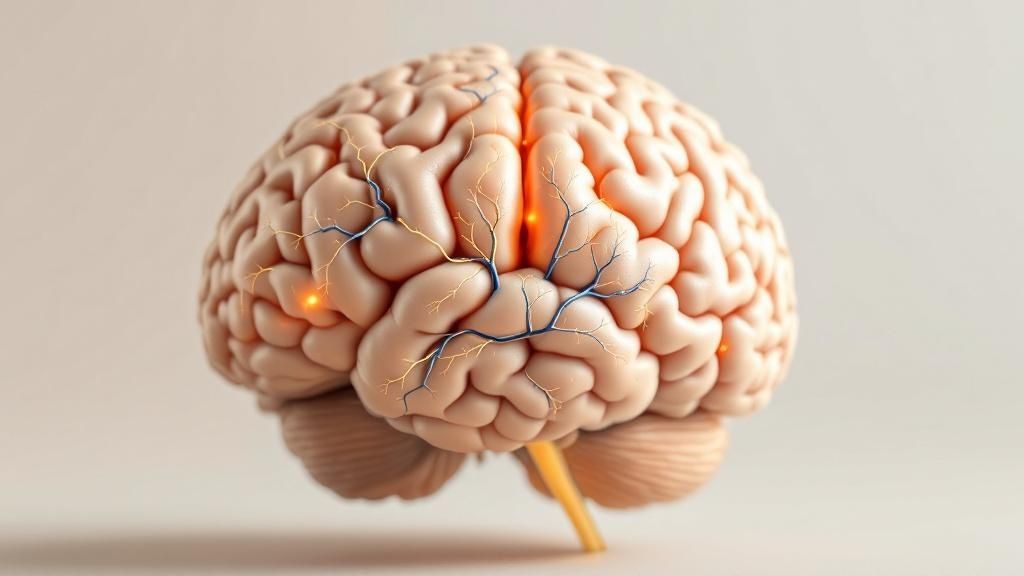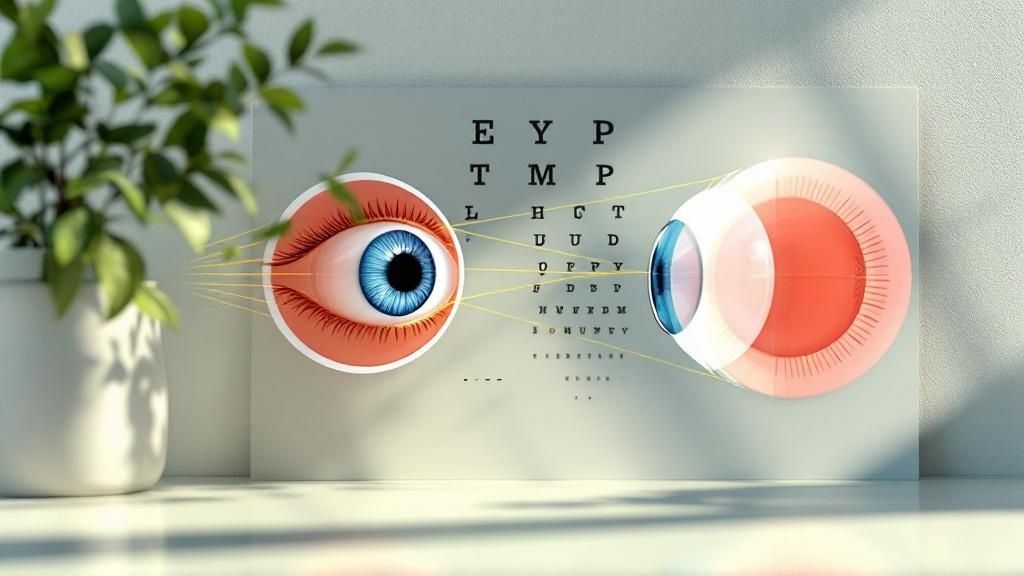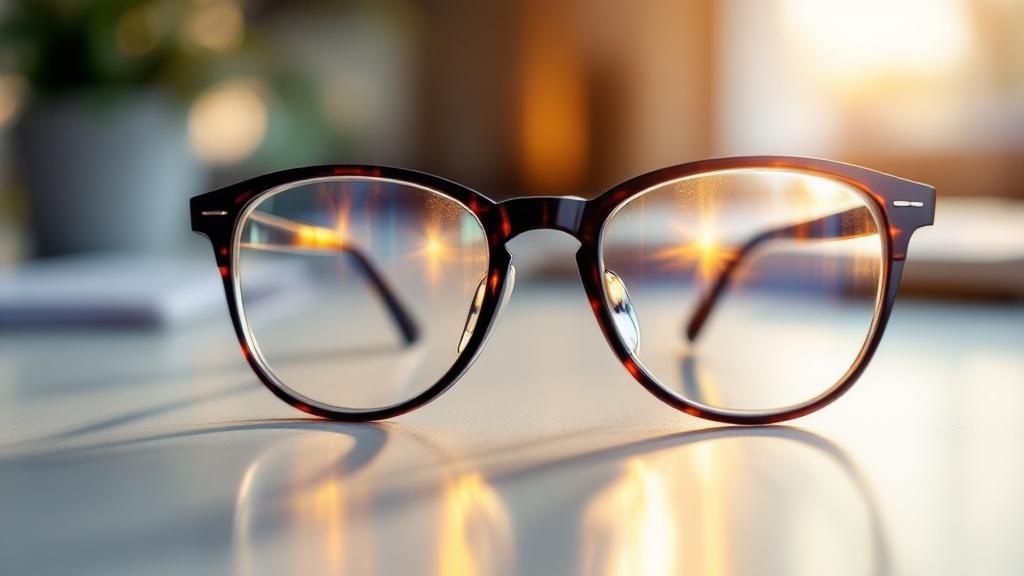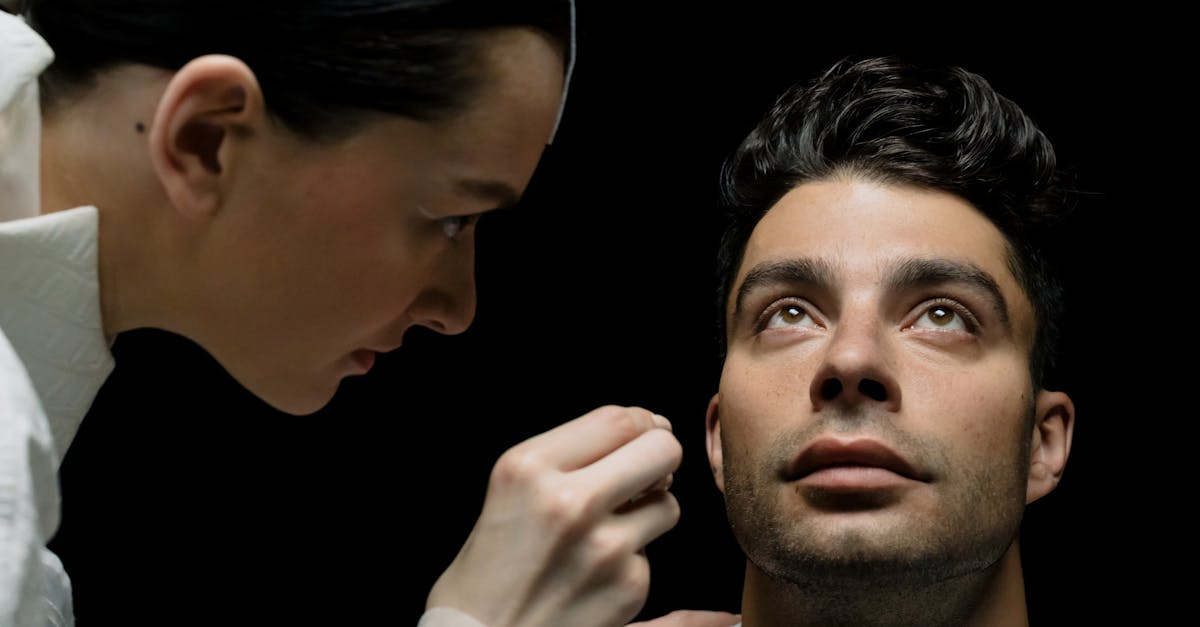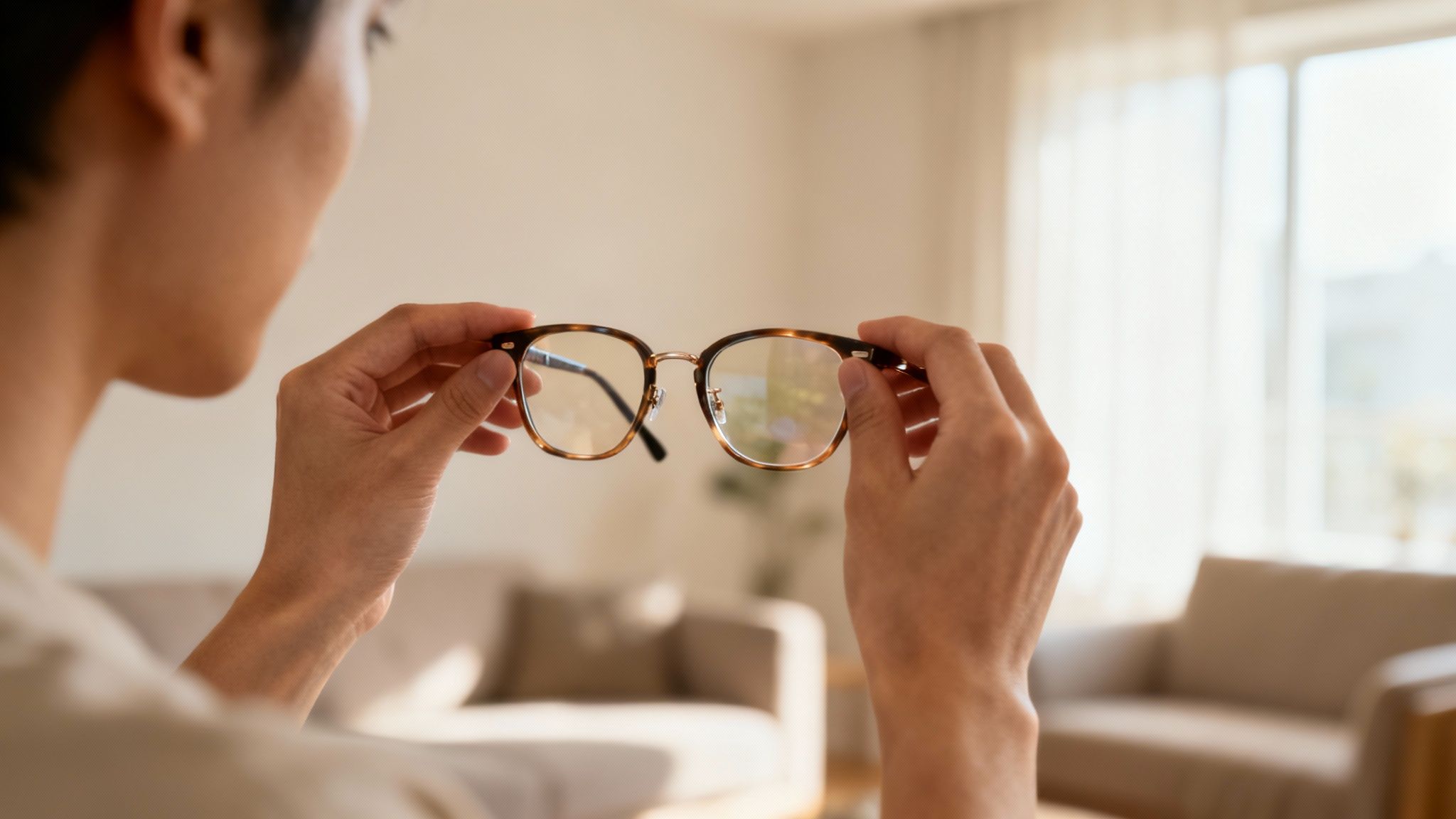When your world suddenly doubles, it’s more than just disorienting—it can be genuinely frightening. Medically, this is called diplopia, and it happens when your eyes and brain just can’t get on the same page to produce a single, clear image. Imagine two movie projectors pointed at the same screen, but they’re just slightly out of alignment. Instead of one crisp picture, you get a blurry, overlapping mess. For our patients in Glendale Heights, IL, and the surrounding areas, understanding the source of double vision is the first step toward finding clarity.
Understanding the Two Main Types of Double Vision
The first thing an eye doctor needs to figure out is which type of double vision you’re experiencing. This is a critical first step because it immediately points us in the right direction, helping us distinguish between a simple issue and a potentially serious underlying condition. At iDoctor, your local optometry boutique in Glendale Heights, we specialize in walking patients through this process, bringing clarity to a confusing situation.
The two categories are defined by a very simple test you can do right now: just cover one eye.
- Monocular Diplopia: This is double vision that persists in just one eye. If you cover the “good” eye and the other one still sees a double image, you have monocular diplopia. This almost always points to a structural problem inside the eye itself, like an issue with the cornea (the eye’s clear front window) or the lens.
- Binocular Diplopia: This is the more common form of double vision. It’s caused by the eyes being misaligned, and it goes away the moment you cover either eye. This tells us your eyes aren’t working together as a team, and your brain is receiving two slightly different pictures that it can’t fuse together.
This visual helps illustrate the core difference.
The key takeaway is that by simply covering one eye, you can provide an immediate and powerful clue about what’s causing your symptoms.
Why This Distinction Matters
For an eye doctor, knowing whether your double vision is monocular or binocular is everything. It helps us, and our patients from nearby areas like Carol Stream and Lombard, narrow down the possibilities right away.
Binocular double vision, for instance, sends us looking for problems with the eye muscles or the cranial nerves that control them. Monocular double vision, on the other hand, keeps our investigation focused on the physical structures of the eye itself.
Monocular vs Binocular Double Vision at a Glance
To make it even clearer, this table breaks down the key differences. Understanding these distinctions can help you describe your symptoms more accurately when you see your doctor.
| Characteristic | Monocular Double Vision | Binocular Double Vision |
|---|---|---|
| Symptom with Both Eyes Open | Seeing double | Seeing double |
| Symptom when One Eye is Covered | Double vision remains in the uncovered eye | Double vision disappears |
| Primary Cause | Structural issue within one eye (e.g., cornea, lens) | Eye misalignment; eyes are not working together |
| Common Analogy | A flawed camera lens creating a ghost image | Two well-functioning cameras pointed at slightly different angles |
This simple comparison can be incredibly helpful. Accurately describing what happens when you cover each eye gives your optometrist a huge head start in the diagnostic process.
Even minor vision problems can become more noticeable with our modern, screen-heavy lifestyles. On a related note, if you spend a lot of time on video calls, you might find our guide on how to choose the best eyeglasses for Zoom meetings useful for enhancing comfort.
Never, ever ignore double vision. While some causes are benign and easily corrected, the sudden onset of diplopia can signal an urgent medical emergency. Getting a professional evaluation isn’t just a good idea—it’s essential for protecting your vision and your overall health.
How Your Eye’s Shape Can Affect Your Vision
Sometimes, the root cause of double vision isn’t hidden deep in your muscles or brain. It can be something much more straightforward: the physical structure of the eye itself. Think of your eye as a finely tuned camera. If any part of its lens system is even slightly off, the picture it sends to your brain will be distorted.
This kind of double vision is known as monocular, a technical term meaning you still see double even if you cover one eye. The good news is that these structural issues are often quite common and, with the right diagnosis, very treatable.
For families in Bloomingdale and Addison, getting to the bottom of these issues is exactly what we specialize in. At iDoctor, our 30-minute detailed eye exams use high-resolution imaging to get an incredibly clear look at your eye’s internal structure. This ensures we can pinpoint the precise cause of your vision problems.
When the Eye’s “Lens” Isn’t Perfectly Shaped
One of the most common structural reasons for double vision is astigmatism. In an ideal eye, the cornea—the clear, front dome of your eye—is perfectly round, like a basketball. This smooth, spherical shape allows light to bend evenly and focus on a single point on the retina, giving you one sharp image.
But with astigmatism, the cornea is shaped more like a football. It’s more curved in one direction than another. Because of this irregularity, light doesn’t focus correctly. Instead of one crisp focal point, you get two, which can make things look blurry, stretched out, or even doubled.
Often, this effect is subtle. You might just notice a slight “ghosting” or shadow around letters on a page or around streetlights at night. While a lot of people have a mild degree of astigmatism, a more significant case can absolutely be a primary cause of monocular double vision.
A Clouded View Through the Lens
Another frequent offender is cataracts. Tucked just behind the colored part of your eye (the iris) is a natural lens. Its entire job is to focus light onto the retina, working just like the lens in a camera.
A cataract is simply a clouding of this natural lens. Over time, it goes from being crystal clear to opaque, almost like trying to see through a foggy or smudged window. This clouding scatters the light passing through, which can create multiple, blurry images and lead to double vision in just that one eye.
Cataracts typically develop slowly as we age and are a major cause of vision problems worldwide. The double vision from a cataract can be especially frustrating at night, where the glare from oncoming headlights often splits into multiple starbursts or halos.
The Impact of an Unstable Tear Film
It might come as a surprise, but even dry eye syndrome can cause double vision. To focus light correctly, your eyes rely on a smooth, stable coating of tears, known as the tear film.
This tear film is the very first surface that light hits when it enters your eye. If that film is unstable or evaporates too quickly, the surface of your eye becomes irregular—think of the distorted view you get when looking through warped glass. This can cause double vision that comes and goes, often getting better for a moment right after you blink because blinking helps spread a fresh layer of tears over the eye.
These kinds of structural issues are incredibly common. It’s estimated that vision impairment affects at least 2.2 billion people globally, with many dealing with conditions that can contribute to double vision. In fact, the leading causes of distance vision problems are uncorrected refractive errors like astigmatism (affecting 88.4 million people) and cataracts (affecting 94 million). You can learn more about these global vision statistics from the World Health Organization.
When Your Eye Muscles Don’t Work Together
Think of the six muscles surrounding each eye as a finely tuned orchestra. For your brain to perceive a single, clear image, every muscle must work in perfect harmony, guiding your eyes to the exact same point at the exact same time. It’s an incredible feat of coordination that happens thousands of times a day without you ever thinking about it.
But what if one of those muscles is out of sync? If even one is weak, damaged, or simply not pulling its weight, your eyes can fall out of alignment.
This misalignment is a condition called strabismus, and it’s a primary cause of binocular double vision. Because your eyes are pointing in slightly different directions, your brain gets two mismatched images it can’t merge. The result is seeing double—the kind that vanishes the moment you cover one eye. It’s a common reason patients from Glen Ellyn and Villa Park visit iDoctor for a precise diagnosis.
Why Do Eye Muscles Get Out of Sync?
The delicate teamwork between your eye muscles can be thrown off for a number of reasons, some starting in childhood and others cropping up unexpectedly in adulthood.
One of the most common is congenital strabismus, where a child is either born with misaligned eyes or develops the condition early on. If it isn’t corrected, the brain often makes a clever adaptation: it starts ignoring the image from the misaligned eye to avoid the confusion of double vision. This can lead to what’s known as amblyopia, or “lazy eye.”
In adults, strabismus can appear suddenly. Sometimes, a mild case from childhood that was kept under control can re-emerge later in life. Other times, the problem isn’t with the muscles themselves but with the nerves that send them signals.
Ever notice your vision getting a little blurry after a long, stressful day? Simple exhaustion can be a factor. The fine motor control needed to keep your eyes perfectly aligned can falter when you’re tired, leading to temporary double vision, especially after hours of intense focus.
The Impact of Digital Eye Strain
Our modern lives have put an unprecedented demand on our eye muscles. Staring at screens for hours on end forces your eyes to converge—or turn inward—to maintain close-up focus. Over time, this constant effort can tire out the muscles responsible for this task.
This can lead to a specific condition known as convergence insufficiency, where your eyes struggle to team up for near-work like reading or scrolling on your phone. The symptoms can be frustrating and disruptive:
- Eyes that feel tired, sore, or just plain uncomfortable.
- Headaches, often felt around the forehead or temples.
- Blurry or double vision, particularly after long sessions on a computer.
- Trouble concentrating when you read.
These issues are often tied to digital eye strain. If this sounds familiar, exploring effective digital eye strain treatment can offer much-needed relief and help you work and read more comfortably.
The good news is that many muscle-related vision problems are very treatable. At iDoctor, a common and highly effective solution is prescribing glasses with prisms. These specialized lenses bend light before it reaches your eye, essentially redirecting the image so that your brain can easily fuse the two views back into one. It’s a simple, non-invasive fix that can restore clear, comfortable vision.
Could a Nerve or Brain Issue Be the Cause?
While problems inside the eye or its muscles are frequent causes, sometimes double vision is a red flag from your body’s control center—the brain and nervous system. This kind of double vision is almost always binocular, which means it vanishes the moment you cover one eye. It points to a breakdown in the incredibly complex teamwork that orchestrates eye movement.
Think of the nerves linking your brain to your eye muscles as an intricate electrical system. For your eyes to move in perfect unison, the signals zipping through these “cables” have to be flawless. If a nerve is damaged, the signals get scrambled, and your eye muscles fall out of sync.
The idea of a brain or nerve issue can be unsettling, which is why any sudden onset of double vision demands immediate attention. Here at iDoctor, we serve as a vital first stop for local residents, such as those in Roselle and Itasca. We provide a thorough assessment needed to pinpoint the root cause and make sure you get the right care, right away.
The Brain’s Role in Vision
A surprisingly large part of your brain is dedicated to processing vision and directing your eyes. When something disrupts this delicate system, diplopia is often one of the first signs.
- Stroke: When a blood vessel in the brain is blocked or bursts, it cuts off oxygen to brain cells. If a stroke hits the brainstem or cerebellum—areas crucial for coordinating eye muscles—sudden double vision can be a direct result.
- Aneurysm: This is a weak, bulging spot on a blood vessel wall in the brain. If it grows large enough to press on a nerve controlling an eye muscle, or if it ruptures, it can cause severe symptoms, including double vision and an explosive headache.
- Brain Tumors or Head Injury: Any kind of trauma or abnormal growth can increase the pressure inside your skull. This pressure can squeeze the cranial nerves that manage eye movement, interfering with their ability to function properly.
These are serious medical emergencies where double vision is rarely the only symptom. If you experience double vision along with a sudden, severe headache, confusion, dizziness, or weakness on one side of your body, seek emergency medical care immediately.
When Nerves and Muscles Can’t Communicate
Sometimes, the problem isn’t with the brain itself but with the communication between the nerves and the muscles they control.
Diplopia is a major reason people seek medical care. In the United States alone, there are around 804,647 outpatient visits for double vision each year. A critical 12.3% of these cases are for acute or subacute diplopia, which often points to an urgent neurological or eye-related condition.
Two well-known conditions that disrupt this nerve-muscle connection are:
- Myasthenia Gravis: This is an autoimmune disorder where the body’s own immune system attacks the connection points between nerves and muscles. It leads to muscle weakness that gets worse with activity and better with rest. The eye muscles are often the first to be affected, causing droopy eyelids and double vision that can fluctuate throughout the day.
- Multiple Sclerosis (MS): In this autoimmune condition, the protective coating (myelin) around nerve fibers in the brain and spinal cord is damaged. This “frayed wiring” disrupts the flow of information. If the nerves controlling the eyes are affected, double vision is a very common symptom.
Because these neurological causes are so complex, a comprehensive eye exam is a vital first step. Your optometrist can perform specific tests to check your eye alignment, muscle function, and nerve health. Understanding why regular exams are so important is key; you can learn more about how often your eyes should be checked in our detailed guide. If we suspect a neurological issue, we will immediately refer you to the right specialist, ensuring no time is wasted in getting you a proper diagnosis and treatment plan.
How Your Overall Health Impacts Your Eyesight
It’s surprising for many people to learn that double vision often isn’t an eye problem at its core. Instead, it can be a red flag for a systemic disease—a condition that affects your entire body. Your eyes really can be a window to your overall health.
Think of it this way: your body is a complex, interconnected machine. When one part, like your thyroid gland or metabolic system, is out of sync, it can create a ripple effect that touches everything, including the delicate nerves and muscles controlling your vision. This is why a thorough eye exam is so important. At iDoctor, we often see patients from Medinah and Schaumburg whose detailed exams reveal the first subtle signs of these broader health issues.
The Connection Between Diabetes and Vision
Diabetes is probably one of the most famous examples of a systemic disease that impacts sight. When blood sugar stays high for too long, it can cause nerve damage throughout the body, a condition called neuropathy.
The tiny, delicate nerves that control your eye muscles are particularly susceptible. If these nerves are damaged, they can’t reliably tell the eye muscles how to work together. This can lead to muscle weakness or even paralysis, throwing your eyes out of alignment and causing binocular double vision.
In some cases, this kind of double vision is the very first symptom that sends someone to the doctor, ultimately leading to a new diabetes diagnosis. Getting blood sugar under control is the most important thing you can do to prevent or improve it.
How Thyroid Issues Can Disrupt Your Eyes
Another major cause is thyroid eye disease, which is often linked to Graves’ disease—an autoimmune disorder where the thyroid goes into overdrive. With this condition, your own immune system mistakenly attacks the tissues surrounding your eyes.
This misguided attack causes the muscles and fatty tissues behind your eye to swell up and become inflamed. As those eye muscles get bigger and stiffer, they lose their ability to move smoothly and freely within the eye socket.
It’s like a skilled puppeteer trying to work a puppet whose strings are tangled and stiff. No matter how perfectly the puppeteer pulls, the puppet can’t move correctly. Your brain is sending the right signals, but the swollen muscles can’t follow orders, leading to misalignment and double vision.
Other Systemic Conditions and Vision
While diabetes and thyroid problems are common culprits, they aren’t the only ones. Neurological disorders like Parkinson’s Disease (PD), for instance, can interfere with the brain’s complex control over eye movements. Double vision, or diplopia, is significantly more common in people with PD. One large study found that 18.1% of PD patients experienced double vision, compared to just 6.3% of people without the disease. Find out more about the link between Parkinson’s and double vision.
This deep connection between your body’s health and your vision really highlights why you can’t look at them separately. Symptoms like double vision are a perfect example of why you should never just brush off something new or unusual. Protecting your vision long-term goes hand-in-hand with managing your overall wellness, and that includes being proactive about other potential eye conditions. For more on this, check out our guide on 5 key strategies for cataract prevention.
Getting a Diagnosis and Seeing Clearly Again
Figuring out what’s causing your double vision is the first real step toward getting your sight back to normal. We understand seeing double can be alarming, but the path to a diagnosis is usually straightforward, and there’s a lot we can do to help. Here at iDoctor, our entire process is built around getting you clear answers and a treatment plan that actually works for your life.
It all starts with a simple conversation. We’ll sit down and talk about exactly what you’re experiencing, go over your health history, and listen to any concerns you have. This isn’t just a checklist for us; it’s how we start piecing together the puzzle of what’s happening with your vision.
How We Diagnose the Problem at iDoctor
The heart of our diagnostic process is our 30-minute detailed eye exam. We don’t believe in rushed appointments. Instead, we dedicate the time to perform a truly thorough evaluation, using some of the best technology available to get a precise look at your eye health.
This in-depth assessment is what lets us nail down the exact cause of your double vision. It could be something as simple as a refractive error, an issue with how your eye muscles are working together, or even a sign of something more complex. It’s this careful approach that has earned us the trust of many patients, such as those from Wheaton and West Chicago. If you’re curious, you can learn more about what happens during an eye exam on our blog.
We use high-resolution imaging that allows us to examine every tiny part of your eye’s structure and function. This technology helps us spot subtle problems that could easily be missed, which is key to getting the diagnosis right the first time.
Custom Treatment Solutions
Once we know why you’re seeing double, we can build a treatment plan just for you. There’s no single fix for diplopia; the right approach depends entirely on the underlying cause.
Some of the most common and effective treatments we provide are:
- Prescription Glasses with Prisms: If your double vision is from a slight eye misalignment (strabismus), we can add special prisms to your eyeglass lenses. These prisms work by bending light before it enters your eye, which helps your brain merge the two images you’re seeing back into one clear picture.
- Specialized Contact Lenses: For certain conditions, custom-designed contact lenses can be a great alternative, correcting the vision problem without the need for glasses.
- Vision Therapy: You can think of this as physical therapy for your eyes. We guide you through a series of specific exercises designed to strengthen your eye muscle coordination and retrain the connection between your eyes and your brain.
We also believe finding the right solution should be exciting, not a chore. We make it easy to find glasses you’ll genuinely love, whether you’re drawn to our curated collection of luxury brands like Gucci and Tom Ford or prefer our practical $125 frame and lens package with anti-reflective coating. Our mission is to make iDoctor in Glendale Heights the go-to place for expert vision care for everyone.
Your Questions About Double Vision, Answered
When you suddenly start seeing double, it’s natural to have a lot of questions and feel a bit uneasy. Getting straightforward answers from an expert is the best way to understand what’s happening and figure out the next steps. Let’s tackle some of the most common concerns we hear from our patients.
Can Stress or Being Really Tired Cause Double Vision?
Absolutely. Think of the part of your brain that controls eye movement as an orchestra conductor. When you’re well-rested, the conductor is sharp, and your eye muscles work together in perfect harmony. But when you’re exhausted or under a lot of stress, that conductor gets tired, and the coordination can slip, causing your eyes to fall slightly out of alignment.
This kind of double vision is almost always temporary and clears up once you get some real rest. However, if it keeps happening or you notice other symptoms alongside it, you need to get it checked out to make sure nothing else is going on.
Any new case of double vision, even if you think you know the cause, really should be looked at by a professional. It’s always better to be safe and get peace of mind.
Is Seeing Double Always a Sign of Something Serious?
Not necessarily, but it always needs to be taken seriously. Sometimes, the cause is simple, like a touch of astigmatism or just plain eye strain that’s easily corrected. On the other hand, double vision can also be the very first red flag for a major health issue, such as a stroke, brain tumor, or multiple sclerosis.
There’s simply no way to know for sure without a complete professional evaluation. If double vision comes on suddenly and is paired with other alarming symptoms—like a splitting headache, dizziness, or weakness on one side of your body—you should treat it as a medical emergency and get help right away.
How Exactly Do Prisms in Glasses Work?
It’s a clever bit of physics, actually. A prism is a special type of lens that bends light. When your eyes are misaligned, they send two slightly different images to your brain, which is what causes the double image.
A prism lens is ground to a specific angle that redirects the light entering one of your eyes. This shifts the image just enough so that it perfectly lines up with the image from your other eye. Your brain can then easily merge them back into a single, crisp picture. We can figure out the exact prism prescription you need and build it directly into your glasses right here at iDoctor.
At iDoctor in Glendale Heights, we’re dedicated to giving you the answers you need and the advanced care you deserve. Since we accept all major vision insurance plans, getting expert care is convenient and accessible. If you’re in the surrounding communities like Hanover Park or Streamwood, our team is ready to help you see clearly and comfortably again. Schedule your detailed eye exam with us today.



